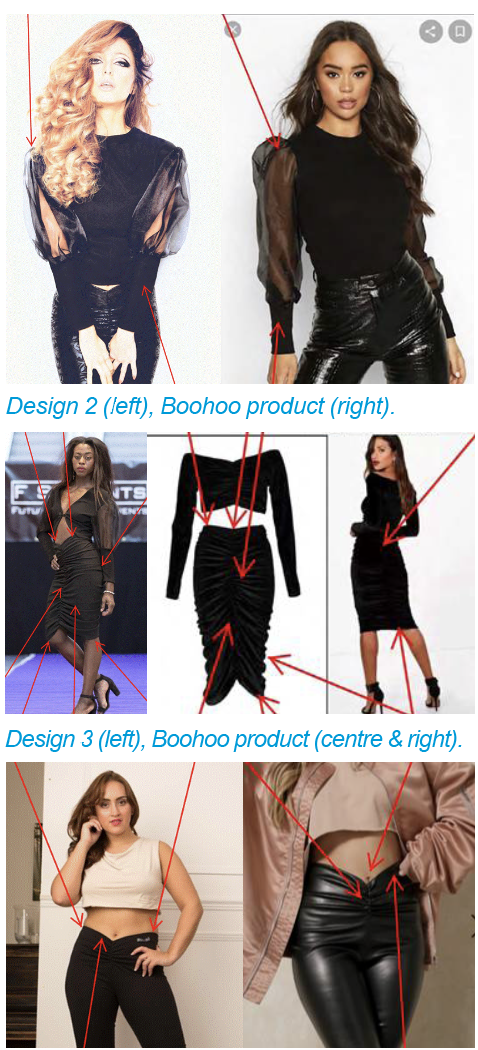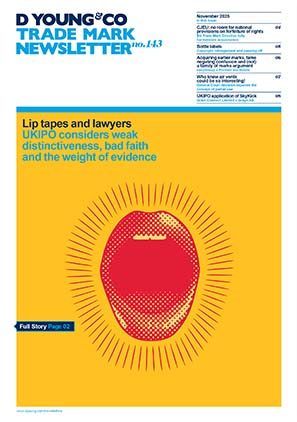Edwards v boohoo: UK unregistered designs on trial
Design rights play an important role in the fashion industry. In this case between the designer, Sonia Edwards, and the fast-fashion company, Boohoo, it was UK unregistered design rights that were in the spotlight.
UK unregistered design rights
UK unregistered design rights have some unique characteristics, as outlined in the four points below. These not only help to explain the outcome of this case (spoiler alert: Ms Edwards does not win!), but help with understanding how UK unregistered design rights protect designs more generally.
1. UK unregistered design rights protect the shape and configuration of an article.
UK unregistered design rights do not protect: surface decoration (for example, a polka dot pattern); methods or principles of construction (for example, organza fabric); or features which enable the article to perform its function.
In addition, UK unregistered design rights cannot protect parts of an article that cannot be seen (for example, a “concealed waistband”).
2. UK unregistered design rights protect designs for 10 - 15 years.
15 years from the date the design is recorded in a document or an article is made to the design, 10 years if that design is commercialised.
3. Designs that are recorded in design documents (for example, sketches, CAD drawings) and with dimensions specified can be far easier to enforce as UK unregistered design rights.
Specific dimensions are useful because enforcement of UK unregistered design rights will involve proving that the design is original (for example, is different from other designs on the market) and the design has been copied. For instance, it will be simpler to demonstrate that a cuff of [x]mm length is original or copied than showing the same for an “extended cuff”. However, design documents are not a requirement for subsistence of UK unregistered design rights, which can also be defined by reference to broad descriptions, images, or photographs.
4. UK unregistered design rights cannot be defined by reference to the way the design interacts with the wearer, as that will vary from person to person.
It would be unworkable for the protectable shape and configuration of UK unregistered design rights to vary depending on the individual who is wearing it. For clothing designs in particular, UK unregistered design rights should be described in their off-the-body configuration, not when being worn.
The designs are cut down to size
This case ultimately concerned five designs. These design were defined broadly and by reference to images of the products originally designed by Ms Edwards. Ms Edwards did not have, or rely on, original design drawings with specific measurements.
Design 1
Design 1 had been commercialised more than ten years ago, and so the IPEC deemed that UK unregistered design rights could not subsist in this design at all given the term of protection had expired.
Only limited features of designs 2 to 5, as broadly defined by Ms Edwards, were deemed to be protectable as UK unregistered design rights for the following reasons.
Design 2
Features protectable as UK unregistered design rights: the puff sleeve connected to an extended cuff.
The court disagreed that UK unregistered design rights subsisted in certain features of design 2 because these:
- Described the nature of materials being used and so would amount to a method or principle of construction. For example, “a rib fabric top”.
- Described how the article interacted with the wearer. For example, how the cuff reaches “from past the wrist” and “under the elbow”.
Designs 3 & 4
Features protectable as UK unregistered design rights: 1) the chevron shape at the back and front of the waist/hem; 2) the ruching which is gathered in the centre; 3) the folds that run down the front and rear centre of the design; and 4) the draping at the leg.
The court disagreed that UK unregistered design rights subsisted in certain features of designs 3 and 4 because these:
- Described how the article interacted with the wearer. For example, the “high waistline”.
- Relied on components that cannot be seen and/or form no part of the shape and configuration. For example, the “lack of seams on the side” and “absence of zips or other fastenings”.
Design 5
Features protectable as UK unregistered design right: a pair of ruched leggings with a “small” chevron at the top, and with ruching only present in the top half of the area between the crotch and the waistline.
The court disagreed that UK unregistered design rights subsisted in certain features of design 5 because these:
- Described how the article interacted with the wearer. For example, the “high fitting waistline”.
- Relied on components that cannot be seen and/or form no part of the shape and configuration. For example, the “Waistband concealed by the material forming the rest of the design”.

Boohoo! No infringement of the UK unregistered design rights
Working from the features protectable as UK unregistered design rights, the IPEC went on to consider whether there was infringement of the UK unregistered design rights in each design by Boohoo. This involved consideration of two key factors:
- whether the Boohoo products are made exactly or substantially to the UK unregistered design rights; and
- whether there was copying of the designs by Boohoo.
Made exactly or substantially to the design
These broad, protectable features of the UK unregistered design rights and the absence of any precise measurements made it relatively simple for Ms Edwards to show that the Boohoo products were made exactly or substantially to the design of the UK unregistered design rights.
Taking design 5 as an example, the protectable features of “a pair of ruched leggings with a “small” chevron at the top, and with ruching only present in the top half of the area between the crotch and the waistline” can be found in the Boohoo product. A similar conclusion was found for designs 3 and 4. However, for design 2, the broad description counted against Boohoo. The protectable features were “the puff sleeve connected to an extended cuff”. The Boohoo product had a much shorter cuff and so was not made exactly or substantially to the UK unregistered design right.
Copying
It was on the requirement to prove copying that Ms Edwards case against Boohoo fell down.
Boohoo provided substantial evidence (including witness evidence at trial) on its design process, which broadly involved reviewing the designs: present on social media feeds, pushed by influencers, worn by celebrities and displayed on catwalks. The Boohoo design teams created designs based upon these influences. Boohoo also bought designs directly from third party designers. This meant there was a high probability that: a) Boohoo came to these designs independently; b) from drawing on other influences; and/or c) that any similarities with Ms Edwards’ designs arose from happenstance given the very high volume of goods and limited design space. The broad definitions also meant that the designs were relatively common and so similarities could have arisen independently.
In addition, there was limited opportunity for Boohoo to copy Ms Edwards’ designs because Ms Edwards’ images would not appear on social media feeds given the time elapsed and the low profile of Ms Edwards’ social media accounts (with a handful of likes and comments on Facebook and only 268 followers on Instagram). Ms Edwards’ images had also not become stock images on sites such as Pinterest.
The ultimate position on infringement was:
- Design 1: no subsistence of UK unregistered design right due to design in 2011.
- Design 2: Boohoo product not made exactly or substantially to the design of the UK unregistered design right.
- Designs 3, 4 & 5: No copying of UK unregistered design right.
Case details at a glance
Jurisdiction: England & Wales
Decision level: IPEC
Parties: Sonia Edwards (claimant) v BOOHOO.COM UK LIMITED, PRETTYLITTLETHING.COM, NASTY GAL LIMITED, MISS PAP UK LIMITED, and DEBENHAMS BRANDS LTD (defendants)
Date: 03 April 2025
Citation: [2025] EWHC 805 (IPEC)
Decision: dycip.com/2025-EWHC-805-IPEC

